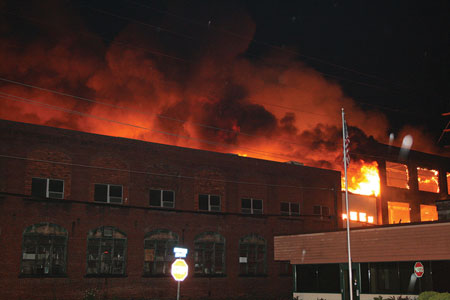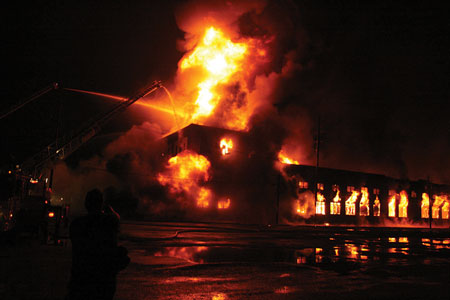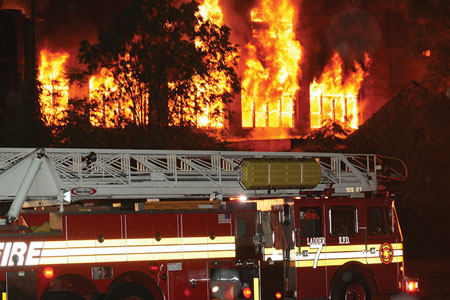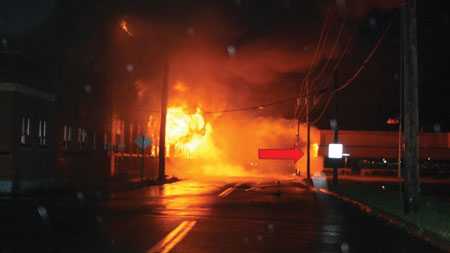By Joseph Pronesti
I work in a typical Middle America fire department. Our “normal” fire is, and always has been, the room-and-contents fire. Sure, we have had our share of larger commercial fires, but we never really knew what the “big one” would be; and for all intents and purposes, we never really planned or prepared for a large fire event. Firefighting can become automatic, and you can become complacent about firefighting. That can lead to issues when you least expect it.
In the early morning hours of July 2, 2008, a mill fire stressed our resources unlike any other fire that occurred before and probably ever will again. This fire provided many lessons I am finally sharing after seven years. I am a proponent of learning from all events, large and small. I hope that my department’s experience will help you prepare for your large event because that large event will happen, and all eyes will be on you.
Elyria is home to approximately 56,000 residents within 21 square miles. At one time, the department had four stations with 80 fully paid members. It is now well below that. In 2008 when this event occurred, we were dealing with severe cutbacks and with an intermittent station closure. Ironically, the complex involved in this fire was in this closed station’s first-due area.
Building and Construction
Pieced together and connected by several entrances, the building, called The General Industries Building, occupied approximately 85,308 square feet on 3.8 acres of property. The oldest sections dated back to 1900; several additions were made in the 1940s and 1950s. The construction was mostly Type IV heavy timber; some buildings incorporated Type III ordinary construction features. The complex is bordered on the north by railroad tracks, on the west by a two-lane commercial street, on the east by a tool and die company, and on the south by another two-lane commercial street. Directly opposite the southern boundary are multiple commercial buildings; one includes one of the largest stockpiles of blood in northern Ohio. Also to the south are three closely spaced residential city blocks that contain numerous single- and multifamily residences.
The Fire
Firefighters received the first call about the building at 1:40 a.m. Six minutes later, Shift Commander Assistant Chief Tim Mitchell arrived and found the loading dock, located in the northeast corner of the complex, engulfed in flames. He put out a second alarm that brought two mutual-aid companies, an engine and a truck, from neighboring communities.
At the time of this call, Mitchell was also hamstrung because the closest engine from Elyria was out of service since the station was closed. The next closest engine was on a call at the police station where an irate inmate broke off a sprinkler head. This left two engines and a ladder, each staffed with three personnel, to try to stop the fast-moving fire. Mitchell’s initial orders were to find a good spot to set up his first-arriving ladder and then have his two engine crews attempt to set up their deck guns on their ground mounts since access to the rear was tight and the fast-spreading fire would have put our apparatus in harm’s way.
Within minutes, the fire spread from the loading dock into the complex. Weather conditions were warm with light rain and very little wind. The complex was mainly vacant except for a custom molder of plastics and a composite molding company for sinks, tubs, and other items. The building had bags and bags of plastic pellets that were used for the molds.
 |
| (1) Within minutes, the fire quickly spread from the loading dock into the complex. (Photos courtesy of Terry Costigan, TMC News.) |
At the time of the fire, I was serving as the department’s interim fire chief. Dispatch notified me at about 0200 hours, and I responded from my residence. I arrived at approximately 0214 hours. After conferring with Mitchell, I assumed command and assigned him to the north side of the complex by the railroad tracks; all rail traffic was stopped.
Fire was now on all three floors of the complex closest to the loading dock. The oil-soaked floors from more than 100 years of machinery and the open cavernous spaces, in my opinion, helped spread the fire. I knew we were in for a long night and water would soon be an issue. I called for our county’s water shuttle. [This type of operation consists of a dump site (large portable pond) and a continuous shuttle of tankers dumping their respective supplies of water, which is drafted and relayed where needed. It works like clockwork in the rural areas of my county; the small volunteer departments have perfected it to a science.] I also called additional mutual-aid alarms that eventually would bring apparatus from all 26 fire departments in the county-something that, to my knowledge, had not occurred prior to or since this event.
The fire eventually consumed the entire complex. Crews were on the scene for the next 16 hours. Numerous mutual-aid chiefs were special called and, along with Elyria chief officers, were assigned around the complex. More on this later.
Exposures
Shortly after my arrival, I noticed that flying brands were beginning to cover the residences bordering the south portion of the complex. Our water shuttle was not set up yet, and I decided that what water we had had to be used to protect these residences in addition to the businesses directly across the street from the complex, which included the Lorain County Blood Bank storage facility that at the time held 70 percent of the area’s blood supply in its refrigerated storage units inside.
Another large concern was the high-tension power lines on wooden poles in close proximity that were now on fire. We had these lines coming down into the middle of the street; the radiant heat made it impossible for power crews to get close to the facility. This is where my mentor Fire Department of New York Deputy Chief (Ret.) Vincent Dunn’s words popped into my head. He warned that a problem with Type IV construction is that a large influx of oxygen creating high quantities of radiant heat and embers could cause a collapse. This condition was beginning and would eventually be our biggest problem.
At one point, we had a large amount of the façade of the blood bank’s building on fire; an Elyria command officer and two engines and a truck from mutual-aid cities were assigned to handle this situation, since the loss of this building and its blood supply would have a prolonged effect on our area. They worked under some extreme conditions to save this building and its contents.
Communication, Command, and Control
As much as I have read, studied, and discussed regarding command and control, the enormity of handling communication cannot be appreciated until you have an incident like this. I strongly recommend that you set up beforehand a policy that will bring command-level chief officers in to assist in dividing up the fireground. The biggest mistake at this fire was having all communication on our main dispatch channel. If you can use tactical simplex frequencies on your fireground, do it. Train and develop policies on how and when to switch; being strictly defensive from the onset made this single-frequency issue less urgent, but, in hindsight, if something had gone wrong or a firefighter emergency had occurred, it could’ve been a communication nightmare. Because we were all operating on a single channel and did not switch or add frequencies, every hour or so I would call a “time out” and huddle with my command and safety officers around the command post and speak face to face to ensure that we were on the same page.
A safety officer was assigned to each side of the building. This brings up another issue: Make sure everyone knows the proper identification for each building side. I thought everyone knew that the A side was where the command post was, but you need to make sure everyone knows this information, especially mutual-aid command officers, who may not be as familiar with the area and structures involved. We had several major collapses as the fire progressed, and we needed all members to be aware of what was going on where. Make sure your fireground is identified, and repeat it throughout your longer campaigns.
My department is a tradition-laden department, and change is hard. Command training for our members, including me, was nonexistent. You basically had to train yourself coming up through the ranks.
 |
| (2) One of the main challenges of fires in Type IV construction is the influx of heat and flying brands after a collapse. Be proactive in your preparation for it. |
One item that always intrigued me was the “stationary command post.” The chief I was used to had a cigarette or a pipe in his mouth and stood out front, or he stuck his head in the front door to monitor your advance, fire conditions, and so on. I read much about the need for and advantages of a fixed post, but I was always afraid to give it a try when commanding a fire. It wasn’t the “Elyria Fire Department way,” especially in 2008.
As things were getting chaotic and I had people basically all around me, I made the best decision of the night: to call for our county emergency management command center. It is basically a huge recreational vehicle with all sorts of communication and cozy comforts. When confronted with your fire large or small, find a fixed command post, and expand it in size as the incident expands-for example, use your SUV for a small room-and-contents fire and a big command center on wheels for a four-block-long old mill fire.
My department never used an assistant or a command aide. Again, I was well-read on the use, but we never had the resources to have such a position. This fire necessitated its use, and I placed Lieutenant Carl Mack, now captain, in this position. This position takes a ton of pressure off the incident commander, and today’s incident management pretty much dictates its assignment. If you don’t have this position staffed full time, make preparations for its use when you have large fire events. Give serious thought ahead of time to who may be best qualified for this assignment. Assigning a rookie to this position will not do you and those under your command any good.
Share Information and Intelligence
The real issues began in two distinct episodes that emphasize the need to get information out on your buildings regardless of whether or not you have an organized preplanning system. One easy excuse in many departments, including mine, was, “We don’t have any preplanning.” If your department does not have an organized preplanning program-and, as of today, mine still does not-it doesn’t mean you cannot still do informal preplanning. The key, however, is to disseminate the information!
This mill complex problem began months earlier when the sprinkler system was placed out of service. Our Fire Prevention Bureau did an outstanding job of recording and documenting the issues of this complex. With that said, I encourage you to not dismiss or take for granted the work of your inspectors or fire prevention officers. The information they obtain is probably more detailed than you can imagine, and it may take an interested attitude on your and your crews’ part to obtain the information; either way, get out into the streets to discuss and mentally preplan.
 |
| (3) The initial truck placement of Elyria’s ladder. The key lesson here is to anticipate where the fire is going to go before you set up, not where the fire is at the time. We had to position this unit several times in the beginning stages. Don’t be in a rush to set up your big guns. Give the fire’s progression some thought. Knowledge of building construction types and fire spread is the key! |
I scoff at those who moan and groan about the lack of an organized preplanning system in their departments. I, too, have complained and whined about it. Stop making excuses, and look at your hazardous buildings the next time you are on an emergency medical services or grocery supply run.
When taking my children to school every morning, I would have to pass this complex. I made mental notes of the complex and its deteriorating condition each day. I took my crews by it as often as I could, and we would also stop and snoop around, looking at possible apparatus placement spots, condition of outside walls, access issues, and so on. Play the “what if” game routinely alone and with those with whom you work. Encourage them to do the same. It’s not going to be an automatic thing with your younger members; you must teach them how to mentally engage the building the same way as you would teach them how to lay a line correctly.
Listen to the “Boots on the Ground”
In his book The Mission, the Men and Me, Peter Blaber, former special operations soldier, describes the necessity of leaders to listen to the members who are in the thick of the action, the “boots on the ground.” They can provide the best information and assist in your tactical planning. In the case of this mill fire, a week before the fire, my department responded to a working fire on the same loading dock it is believed the large fire started. The first fire occurred during the day and although it took excessive overhaul and control, the fire did little damage and never made it inside the complex. The assistant chief and shift commander that day made this ominous statement: “If this fire occurred at night, we would’ve had a ton of issues.” I didn’t necessarily disregard totally his statement at that time, but, in hindsight, I should have made it a point to reissue warnings about this complex and the fact that the sprinkler system was still out of service.
 |
| (4) Exposures were an immediate issue. For the first time in my career, I had to consider “the value” of the exposure when determining priorities. The arrow is pointing to the Lorain County Blood Bank building. Resources were scarce, but the crews assigned to this exposure did an excellent job saving this building and the blood supply under high heat conditions. |
Don’t assume that every note, bulletin, or procedure will be remembered for years to come. Reminding and revisiting issues need to be a part of your department’s daily activity. I didn’t listen as intently as I should have to my “boots on the ground” and emphasize the need to preplan and study this complex in case a major fire were to break out. I could have used it as an excuse to highlight the need for gathering intelligence for buildings in our city and the importance of knowing your buildings. I never had time; 0114 hours on July 2 crept up on the Elyria Fire Department quickly.
Train on the Big Guns
When was the last time you timed your crews when setting up ground mount monitors? How quickly can your truck operators disconnect and remove your million-dollar aerials from an advancing fire or a soon-to-be collapse zone? Can your young pump operators handle pumping large lines and complicated layouts, or are they simply okay with the one-line fire? These issues all came into play for us, and while I applaud my fellow firefighters and told the reporters that Elyria citizens should be proud of their department that night, I knew we escaped a ton of issues that could have occurred. Don’t train only on the one line; train on the big-gun fires, too!
Five Big “Take Away” Lessons
Following are just some of the lessons learned from this incident.
- Get out and find your “General Industry” buildings. Even without a formal preplan program, you and those under your command can and should analyze these buildings. The use of technology today makes this even easier than it was seven years ago. Stop the excuses, and do it.
- Prepare to manage communications at these events. I highly recommend the use of additional channels for, say, command, staging, and so on. See what works for you and your department so you won’t have to guess when it happens for real.
- Knowledge of building construction and fire spread needs to be a focal point for all members of your department. As stated previously, the writings of Vincent Dunn were at the forefront of my mind during the fire and the issues we encountered with Type IV construction. I was also naïve enough to think that all those on the fireground that night were aware of the same points. I cannot emphasize this enough: A good building construction and fire spread education program in your department is worth its weight in gold. It’s also very easy to create one today. There is plenty of information available; make sure your members are fully up to speed. It can be the forgotten item in today’s fire behavior-accentuated thought process disseminated by social media.
- Train and prepare for the use of mutual-aid chief officers if you are from a smaller department. Create training opportunities with fellow chiefs from around your area. Many line-of-duty death reports state that lack of command and control was a contributing factor. In my opinion, this doesn’t always point to one single person being in command but perhaps to the failure to sector off and break the fireground into manageable pieces, involving multiple safety officers in command.
- When small fires occur in these buildings, use them as an opportunity to share and remind your members of the potential for a large fire. Don’t assume an e-mail or a bulletin on the building sent out years ago will be remembered. How many new members do you have who may not even know about particular buildings or issues? How do you know all your members even read their respective department e-mails? As far back as 2006, our fire marshal sent out memos describing the hazards and safety issues. Keep in mind that you need to keep these warnings current in every firefighter’s mind! Preplanning programs does not have to be expensive or real elaborate, but their need is ever present.
JOSEPH PRONESTI is a 27-year veteran of the Elyria (OH) Fire Department, where he is a shift captain. He is a graduate of the Ohio Fire Chiefs’ Executive Officer program and a lead instructor at the Cuyahoga (OH) County Community College Fire Academy. He is a contributor to fire service publications and sites, including Fire Engineering, FireEngineering.com, FirefighterNation.com, and TheFireOfficer.com on PennWell’s FireEMS Blog site.
Fire Protection: Preplanning : A Vacation Approach
Use Open Sources of Intelligence as a Preplanning Aid
Preplanning Pays Off
More Fire Engineering Issue Articles
Fire Engineering Archives

